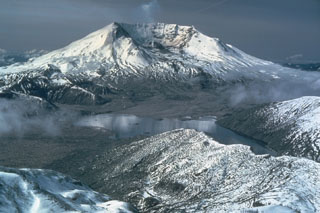Report on St. Helens (United States) — 28 November-4 December 2007
Smithsonian Institution / US Geological Survey
Weekly Volcanic Activity Report, 28 November-4 December 2007
Managing Editor: Sally Sennert.
Please cite this report as:
Global Volcanism Program, 2007. Report on St. Helens (United States) (Sennert, S, ed.). Weekly Volcanic Activity Report, 28 November-4 December 2007. Smithsonian Institution and US Geological Survey.
St. Helens
United States
46.2°N, 122.18°W; summit elev. 2549 m
All times are local (unless otherwise noted)
Data from deformation-monitoring instruments indicated that during 28 November-4 December lava-dome growth at Mount St. Helens continued. Small inflation-deflation events occurred which were interpreted as dome-growth pulses. Seismicity persisted at low levels, punctuated by M 1.5-2.5, and occasionally larger, earthquakes. A GPS receiver on the W part of the active spine showed continued SW advance at a rate of 3-4 mm per day since September 2007. An image from a camera on the NE flank from 28 November showed no notable landscape changes. Clouds occasionally inhibited visual observations.
Geological Summary. Prior to 1980, Mount St. Helens was a conical volcano sometimes known as the Fujisan of America. During the 1980 eruption the upper 400 m of the summit was removed by slope failure, leaving a 2 x 3.5 km breached crater now partially filled by a lava dome. There have been nine major eruptive periods beginning about 40-50,000 years ago, and it has been the most active volcano in the Cascade Range during the Holocene. Prior to 2,200 years ago, tephra, lava domes, and pyroclastic flows were erupted, forming the older edifice, but few lava flows extended beyond the base of the volcano. The modern edifice consists of basaltic as well as andesitic and dacitic products from summit and flank vents. Eruptions in the 19th century originated from the Goat Rocks area on the N flank, and were witnessed by early settlers.
Source: US Geological Survey Cascades Volcano Observatory (CVO)

